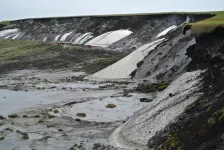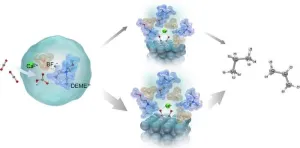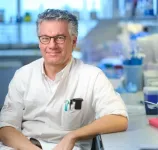(Press-News.org) Permafrost soils store large quantities of organic carbon and are often portrayed as a critical tipping element in the Earth system, which, once global warming has reached a certain level, suddenly and globally collapses. Yet this image of a ticking timebomb, one that remains relatively quiet until, at a certain level of warming, it goes off, is a controversial one among the research community. Based on the scientific data currently available, the image is deceptive, as an international team led by the Alfred Wegener Institute has shown in a recently released study. According to their findings, there is no single global tipping point; rather, there are numerous local and regional ones, which “tip” at different times, producing cumulative effects and causing the permafrost to thaw in step with climate change. As such, taking decisive action today is all the more important if our goal is to preserve as much permafrost as possible. The study was just released in the journal Nature Climate Change.
Permafrost ground covers roughly a quarter of the landmass in the Northern Hemisphere and stores tremendous quantities of organic carbon in the form of dead plant matter. As long as it remains frozen, this matter remains intact – but when permafrost thaws, microorganisms begin breaking it down, releasing large amounts of carbon into the atmosphere as CO2 and methane. Accordingly, rising temperatures worldwide could activate this massive reservoir and substantially worsen climate change through additional emissions. Consequently, in the public debate you’ll frequently encounter the idea of a “ticking carbon timebomb”. This is based on the assumption that the permafrost, like the Greenland Ice Sheet, is one of several tipping elements in the Earth system. In this view, permafrost will initially experience only gradual thawing in response to global warming; then, once a critical threshold value is surpassed, the thawing processes will suddenly begin amplifying one another, leading to the rapid and irreversible collapse of permafrost across the Arctic. Though many have speculated that this type of thawing scenario is possible, to date it has remained unclear whether there really is any such threshold value, and if so, what the corresponding temperature limit is.
An international research team led by Dr Jan Nitzbon from the Alfred Wegener Institute, Helmholtz Centre for Polar and Marine Research (AWI) has now gotten to the bottom of this question. “In fact, the idea of permafrost being a global tipping element is a controversial one in the research community. The IPCC also pointed out this uncertainty in its latest Assessment Report,” says the AWI expert. “Our goal was to close this gap in our knowledge. For our study, we compiled the available academic literature on those processes that can influence and accelerate the thawing of permafrost. Combining it with our own data analysis, we assessed all current findings on thawing processes in terms of whether and, if so, on which spatial scale – local, regional, global – they could lead to self-perpetuating thawing and therefore to a ‘tipping’ in connection with a given level of warming.”
The study’s findings are clear: there are indeed geological, hydrological and physical processes that are self-amplifying and, in some cases, irreversible; however, these are acting only locally or regionally. One example: the formation of what are known as thermokarst lakes. Here, the ice inside permafrost soils melts, creating depressions. The meltwater collects at their surface, producing a dark lake that absorbs large quantities of solar energy. This in turn intensifies the warming of permafrost underneath the water, creating a self-sustaining thawing process in and around the lake. They also found similarly amplifying feedbacks in other permafrost-relevant processes, like the loss of boreal conifer forests due to fire – but here, too, only at the local to regional scale. “There is no evidence of self-amplifying internal processes that, from a certain degree of global warming, affect all permafrost and accelerate its thawing globally,” Jan Nitzbon explains. “Moreover, the projected release of greenhouse gases wouldn’t lead to a global upsurge in warming by the end of the century. As such, portraying the permafrost as a global tipping element is misleading.”
But that doesn’t mean Arctic permafrost is nothing to worry about – on the contrary, the study clearly shows that the permafrost zone is very heterogenous. Consequently, numerous small, local tipping points will be exceeded at different times and warming levels, accumulating over time. As a result, the global thawing of permafrost will not constitute a gradual increase followed by a sudden surge; rather, it will intensify in step with global warming, ending with the total loss of the permafrost once global warming reaches 5 to 6 degrees Celsius. “That means more and more regions are already or soon will be inevitably affected by thawing,” says the AWI researcher. “In other words, there is no safety margin of warming – as the image of the tipping point suggests – that we can still exploit as long as we don’t exceed the threshold value. That’s why we need to keep a close eye on the permafrost regions through even better monitoring, gain a better grasp of the processes involved, and represent them in climate models to further reduce the sources of uncertainty. And one more thing is clear with regard to the greenhouse-gas emissions-based permafrost loss: the sooner that humankind can achieve net-zero emissions, the more regions can be preserved as unique habitats and carbon reservoirs.”
END
Thawing permafrost: Not a climate tipping element, but nevertheless far-reaching impacts
AWI experts find no evidence of a global climate tipping point in connection with permafrost; rather, permafrost soils are thawing in step with global warming
2024-06-03
ELSE PRESS RELEASES FROM THIS DATE:
To eliminate COVID-era bloodstream infections in heart, lung patients, Tampa Hospital had to innovate
2024-06-03
San Antonio, Texas – June 3, 2024 – Recognizing an unusual prevalence of bloodstream infections (BSI) that threatened extremely ill patients receiving Extracorporeal Membrane Oxygenation, or ECMO, Tampa General Hospital (TGH) infection preventionists started an intervention that eliminated these infections completely from their 18-bed Cardiothoracic Intensive Care Unit (CTICU).
At the APIC 2024 Annual Conference, presenters from the 1,000-bed, tertiary care, academic medical system reported on how they reduced bloodstream infections in ECMO patients from a rate of 36% in October 2021 to a rate of 0% in April 2022. This rate was sustained for seven ...
New pathways for treating never-smoker lung cancer revealed
2024-06-03
The primary cause of lung cancer is smoking. However, the incidence of lung cancer among never-smokers has been steadily increasing, especially among women. While approximately 80% of never-smoking lung cancer patients are prescribed targeted therapies that focus on mutations in proteins such as EGFR and ALK, the remaining patients often receive cytotoxic chemotherapy with high side effects and relatively low response rates, highlighting the urgent need for targeted therapies.
Dr. Lee Cheolju's ...
Efficient CO2 conversion to fuels and chemicals using ionic liquid electrolyte
2024-06-03
Converting CO2 into fuel and chemicals using electricity, also known as electrochemical conversion of CO2, is a promising way to reduce emissions. This process allows us to use carbon captured from industries and the atmosphere and turn it into resources that we usually get from fossil fuels.
To advance ongoing research on efficient electrochemical conversion, scientists from Doshisha University have introduced a cost-effective method to produce valuable hydrocarbons from CO2. The study was made available online on 17 May 2024 and formally published in the journal Electrochimica Acta on 20 July 2024. The research team, led by Professor Takuya Goto and including Ms. Saya Nozaki from ...
Intoxication without alcohol: Auto-brewery syndrome
2024-06-03
How can someone have alcohol intoxication without consuming alcohol? Auto-brewery syndrome, a rare condition in which gut fungi create alcohol through fermentation, is described in a case study in CMAJ (Canadian Medical Association Journal) https://www.cmaj.ca/lookup/doi/10.1503/cmaj.231319.
“Auto-brewery syndrome carries substantial social, legal, and medical consequences for patients and their loved ones,” writes Dr. Rahel Zewude, University of Toronto, with coauthors. “Our patient had several [emergency department] visits, was assessed by internists and psychiatrists, and was certified ...
HPV-based screening can help eliminate cervical cancer
2024-06-03
Implementing human papillomavirus (HPV)-based screening in British Columbia could eliminate cervical cancer in the province before 2040, according to a modelling study in CMAJ (Canadian Medical Association Journal) https://www.cmaj.ca/lookup/doi/10.1503/cmaj.231682.
More than 90% of cervical cancer cases worldwide are caused by 9 types of high-risk HPV. The World Health Organization and the Canadian Partnership Against Cancer (CPAC) have both set targets to eliminate cervical cancer by 2040, defined as an annual rate of less than 4 per 100 000 women.
The Pap test has been the primary screening ...
New biomarkers will enable personalised influenza vaccination schedule
2024-06-03
Berlin, Germany: While influenza infection is a significant public health threat, causing serious illness in between three and five million people worldwide per year and leading to about up to 650,000 deaths, the effectiveness of influenza vaccines varies considerably between individuals depending on vaccine types and individual circumstances. A person’s ability to resist infection (host immunity) plays an important role in this. Now, researchers have developed a way of classifying host immunity in individuals, which may lead to the early identification of those who will not respond well to a regular vaccine schedule and therefore ...
Understanding how abnormal embryos self-correct may provide women with a better chance of IVF pregnancy
2024-06-03
Berlin, Germany: Aneuploidy (the presence of an abnormal number of chromosomes) in embryos is a major cause of impaired embryo development, leading to conditions such as Down syndrome, as well as to pregnancy loss. The transfer of such embryos in women undergoing IVF is therefore usually avoided because of unfavourable pregnancy outcomes. But mosaic embryos, comprising both genetically normal and abnormal cells, can result in perfectly normal babies. Now, researchers have been able to understand how these mosaic ...
Metformin may be as safe as insulin during pregnancy, 11-year data shows
2024-06-02
BOSTON—Metformin is safe to use during pregnancy to manage diabetes, with no long-term adverse effects on the children born and their mothers for at least 11 years after childbirth, according to research presented Sunday at ENDO 2024, the Endocrine Society’s annual meeting in Boston, Mass. This is the first study to look at longer term effects of metformin use during pregnancy.
“Metformin has been extensively used for managing raised blood glucose values in pregnancy for many decades now. It is the only blood glucose-lowering oral medication approved ...
Two medication classes reduced cardiovascular and liver events in people with type 2 diabetes
2024-06-02
BOSTON—GLP-1 receptor agonists (GLP-1s) and SGLT-2 inhibitors lower the risk of major cardiovascular events like heart attacks and severe liver complications compared to other diabetes treatments, according to data being presented Sunday at ENDO 2024, the Endocrine Society’s annual meeting in Boston, Mass.
“Before this study, there was limited information about how these specific diabetes medications work in patients with both type 2 diabetes and metabolic dysfunction-associated steatotic liver disease (MASLD),” said Alexander Kutz, M.D., M.P.H., M.Sc., a research fellow in the Division of Pharmacoepidemiology and Pharmacoeconomics, Department of Medicine, at Brigham ...
Neoadjuvant Immunotherapy for early stage melanoma shows positive results
2024-06-02
Immunotherapy before surgery for patients with metastatic melanoma appears to be especially successful. Fifty-nine percent of patients responds so well to this therapy that adjuvant treatment is no longer needed, according to the results of the NADINA study that were published today.
The NADINA study, led by researchers from the Netherlands Cancer Institute, was named one of the eleven clinical studies with the biggest impact on health care in 2024 by Nature Medicine. The study now proves that this was not an empty claim, as shown by the results presented by medical oncologist and research leader Christian Blank today during ASCO 2024, the international congress ...
LAST 30 PRESS RELEASES:
DNA ties gut motility to vitamin B1
Study suggests pathway for life-sustaining conditions in Europa’s ocean
Researchers discover potential new target to treat Parkinson’s disease
Global societies unite to address environmental threats to heart health
Artificial light at night extends pollen season
Women see AI as riskier than men do
Push and pull in models of human migration
Mapping comedic timing, ta-da!
SEOULTECH researchers reveal strong public support for hydrogen fuel cell trucks
Dongguk University develops a new way to produce cheaper, more efficient green hydrogen
Scientists discover a hidden RNA “aging clock” in human sperm
New quantum boundary discovered: Spin size determines how the Kondo effect behaves
Ancient ‘spaghetti’ in dogs’ hearts reveals surprising origins of heartworm
Full value added tax on meat: a first step towards pricing the environmental damages caused by diets
Hidden mpox exposure detected in healthy Nigerian adults, revealing under-recognized transmission
Shingles vaccine linked to slower biological aging in older adults
A self-assembling shortcut to better organic solar cells
A two-week leap in breeding: Antarctic penguins’ striking climate adaptation
Climate risks to insurance and reinsurance of global supply chains
58% of patients affected by 2022 mpox outbreak report lasting physical symptoms
Golden Gate method enables rapid, fully-synthetic engineering of therapeutically relevant bacteriophages
Polar weather on Jupiter and Saturn hints at the planets’ interior details
Socio-environmental movements: key global guardians of biodiversity amid rising violence
Global warming and CO2 emissions 56 million years ago resulted in massive forest fires and soil erosion
Hidden order in quantum chaos: the pseudogap
Exploring why adapting to the environment is more difficult as people age
Society for Laboratory Automation and Screening welcomes new scientific director: Madeline M. Farley, Ph.D.
Austrian cow shows first case of flexible, multi-purpose tool use in cattle
Human nasal passages defend against the common cold and help determine how sick we get
Research alert: Spreading drug costs over the year may ease financial burden for Medicare cancer patients
[Press-News.org] Thawing permafrost: Not a climate tipping element, but nevertheless far-reaching impactsAWI experts find no evidence of a global climate tipping point in connection with permafrost; rather, permafrost soils are thawing in step with global warming



